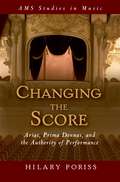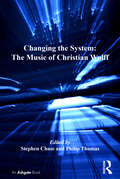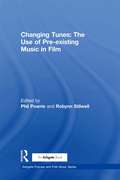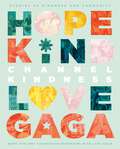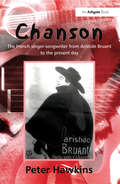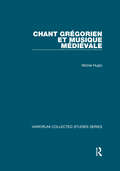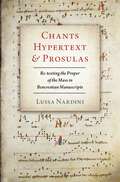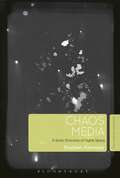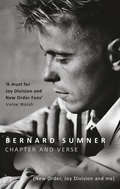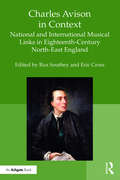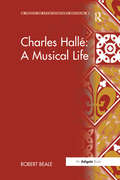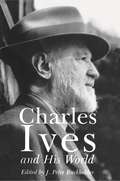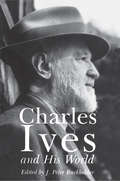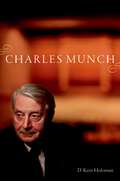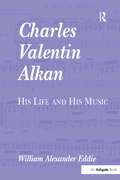- Table View
- List View
Changing the Score: Arias, Prima Donnas, and the Authority of Performance (AMS Studies in Music)
by Hilary PorissThis study seeks to explore the role and significance of aria insertion, the practice that allowed singers to introduce music of their own choice into productions of Italian operas. Each chapter investigates the art of aria insertion during the nineteenth century from varying perspectives, beginning with an overview of the changing fortunes of the practice, followed by explorations of individual prima donnas and their relationship with particular insertion arias: Carolina Ungher's difficulties in finding a "perfect" aria to introduce into Donizetti's Marino Faliero; Guiditta Pasta's performance of an aria from Pacini's Niobe in a variety of operas, and the subsequent fortunes of that particular aria; Maria Malibran's interpolation of Vaccai's final scene from Giulietta e Romeo in place of Bellini's original setting in his I Capuleti e i Montecchi; and Adelina Patti's "mini-concerts" in the lesson scene of Il barbiere di Siviglia. The final chapter provides a treatment of a short story, "Memoir of a Song," narrated by none other than an insertion aria itself, and the volume concludes with an appendix containing the first modern edition of this short story, a narrative that has lain utterly forgotten since its publication in 1849. This book covers a wide variety of material that will be of interest to opera scholars and opera lovers alike, touching on the fluidity of the operatic work, on the reception of the singers, and on the shifting and hardening aesthetics of music criticism through the period.
Changing the System: The Music of Christian Wolff
by Stephen ChaseChristian Wolff is a composer who has followed a distinctive path often at the centre of avant-garde activity working alongside figures such as John Cage, Merce Cunningham, and Cornelius Cardew. In a career spanning sixty years, he has produced a significant and influential body of work that has aimed to address, in a searching and provocative manner, what it means to be an experimental and socially aware artist. This book provides a wide-ranging introduction to a composer often overlooked despite his influence upon many of the major figures in new music since the 1950s from Cage to John Zorn to the new wave of experimentalists across the globe. As the first detailed analysis of the music of this prolific and highly individual composer, Changing the System: The Music of Christian Wolff contains contributions from leading experts in the field of new and experimental music, as well as from performers and composers who have worked with Wolff. The reception of Wolff's music is discussed in relation to the European avant-garde and also within the context of Wolff's association with Cage and Feldman. Music from his earliest compositions of the 1950s, the highly indeterminate scores, the politically-inspired pieces up to the most recent works are discussed in detail, both in relation to their compositional techniques, general aesthetic development, and matters of performance. The particular challenges and aesthetic issues arising from Wolff's idiosyncratic notations and the implications for performers are a central theme. Likewise, the ways in which Wolff's political persuasions - which arguably account for some of the notational methods he chooses - have been worked out through his music, are examined. With a foreword by his close associate Michael Parsons, this is a valuable addition to experimental music literature.
Changing the System: The Music of Christian Wolff
by Stephen ChaseChristian Wolff is a composer who has followed a distinctive path often at the centre of avant-garde activity working alongside figures such as John Cage, Merce Cunningham, and Cornelius Cardew. In a career spanning sixty years, he has produced a significant and influential body of work that has aimed to address, in a searching and provocative manner, what it means to be an experimental and socially aware artist. This book provides a wide-ranging introduction to a composer often overlooked despite his influence upon many of the major figures in new music since the 1950s from Cage to John Zorn to the new wave of experimentalists across the globe. As the first detailed analysis of the music of this prolific and highly individual composer, Changing the System: The Music of Christian Wolff contains contributions from leading experts in the field of new and experimental music, as well as from performers and composers who have worked with Wolff. The reception of Wolff's music is discussed in relation to the European avant-garde and also within the context of Wolff's association with Cage and Feldman. Music from his earliest compositions of the 1950s, the highly indeterminate scores, the politically-inspired pieces up to the most recent works are discussed in detail, both in relation to their compositional techniques, general aesthetic development, and matters of performance. The particular challenges and aesthetic issues arising from Wolff's idiosyncratic notations and the implications for performers are a central theme. Likewise, the ways in which Wolff's political persuasions - which arguably account for some of the notational methods he chooses - have been worked out through his music, are examined. With a foreword by his close associate Michael Parsons, this is a valuable addition to experimental music literature.
Changing Tunes: The Use of Pre-existing Music in Film
by Robynn StilwellThe study of pre-existing film music is now a well-established part of Film Studies, covering 'classical' music and popular music. Generally, these broad musical types are studied in isolation. This anthology brings them together in twelve focused case studies by a range of scholars, including Claudia Gorbman, Jeongwon Joe, Raymond Knapp, and Timothy Warner. The first section explores art music, both instrumental and operatic; it revolves around the debate on the relation between the aural and visual tracks, and whether pre-existing music has an integrative function or not. The second section is devoted to popular music in film, and shows how very similar the functions of popular music in film are to the supposedly more 'elite' classical music and opera. Case studies in part 1: Eyes Wide Shut, Raging Bull, Brief Encounter, Detective, The Godfather Part III, three versions of the Carmen story (DeMille's, Preminger's and Rosi's), Amadeus, The Birth of a Nation, M: Eine Stadt sucht einen MA rder, Needful Things, Rat Race. Case studies in part 2: various films by AlmodA^3var, Young Frankenstein, Pulp Fiction, Trainspotting, Amelie, High Fidelity, Ghost World, Heavenly Creatures, The Virgin Suicides, and the video Timber by Coldcut.
Changing Tunes: The Use of Pre-existing Music in Film
by Robynn StilwellThe study of pre-existing film music is now a well-established part of Film Studies, covering 'classical' music and popular music. Generally, these broad musical types are studied in isolation. This anthology brings them together in twelve focused case studies by a range of scholars, including Claudia Gorbman, Jeongwon Joe, Raymond Knapp, and Timothy Warner. The first section explores art music, both instrumental and operatic; it revolves around the debate on the relation between the aural and visual tracks, and whether pre-existing music has an integrative function or not. The second section is devoted to popular music in film, and shows how very similar the functions of popular music in film are to the supposedly more 'elite' classical music and opera. Case studies in part 1: Eyes Wide Shut, Raging Bull, Brief Encounter, Detective, The Godfather Part III, three versions of the Carmen story (DeMille's, Preminger's and Rosi's), Amadeus, The Birth of a Nation, M: Eine Stadt sucht einen MA rder, Needful Things, Rat Race. Case studies in part 2: various films by AlmodA^3var, Young Frankenstein, Pulp Fiction, Trainspotting, Amelie, High Fidelity, Ghost World, Heavenly Creatures, The Virgin Suicides, and the video Timber by Coldcut.
Channel Kindness: Stories of Kindness and Community
by Born This Way Foundation Reporters with Lady Gaga Lady GagaChannel Kindness is a collection of fifty-one stories of kindness, bravery, and resilience from young people all over the world collected by the Born This Way Foundation and introduced by Lady Gaga.For Lady Gaga, kindness is the driving force behind everything she says and does. The quiet power of kindness can change the way we view one another, our communities, and even ourselves. She embodies this mission, and through her work, brings more kindness into our world every single day.Lady Gaga has always believed in the importance of being yourself, being kind to yourself and others, no matter who they are or where they come from. With that sentiment in mind, she and her mother, Cynthia Germanotta, founded Born This Way Foundation, a nonprofit organization dedicated to making the world a kinder and braver place. Through the years, they’ve collected stories of kindness, bravery, and resilience from young people all over the world, proving that kindness truly is the universal language. And now, we invite you to read these stories and follow along as each and every young author finds their voice, just as Lady Gaga has found hers.Within these pages, you’ll meet young changemakers who found their inner strength, who prevailed in the face of bullies, who started their own social movements, who decided to break through the mental health stigma and share how they felt, who created safe spaces for LGBTQ+ youth, and who have embraced kindness with every fiber of their being by helping others without the expectation of anything in return.Individually and collectively, the stories collected here prove that kindness not only saves lives but builds community. Kindness is inclusion, it is pride, it is empathy, it is compassion, it is self-respect and it is the guiding light to love. Kindness is always transformational, and its never-ending ripples result in even more kind acts that can change our lives, our communities, and our world.
Chanson: The French Singer-Songwriter from Aristide Bruant to the Present Day
by Peter HawkinsEn France, tout finit par des chansons' is the well-known phrase which sums up the importance of chanson for the French. A song tradition that goes back to the Middle Ages and troubadours of the twelfth and thirteenth centuries, chanson is part of the texture of everyday life in France - a part of the national identity and a barometer of popular taste. In this first study of chanson in English, Peter Hawkins examines the background to the genre and the difficulties in defining what is and what is not chanson. The focus then moves to the development of the singer-songwriter of chanson from 1880 to the present day. This period saw the emergence of national icons from Aristide Bruant at the end of the nineteenth century through to internationally recognized musicians such as Jacques Brel and Serge Gainsbourg. Each of these figures used chanson to express the particular moral dilemmas, tragic situations and moments of euphoria particular to themselves and their times. The book provides bibliographies, discographies and details of video recordings for each of the singer-songwriters that it discusses. It is both an essential reference guide to the genre and a useful case history of the adaptation of an ancient form to the demands of the modern mass media.
Chanson: The French Singer-Songwriter from Aristide Bruant to the Present Day
by Peter HawkinsEn France, tout finit par des chansons' is the well-known phrase which sums up the importance of chanson for the French. A song tradition that goes back to the Middle Ages and troubadours of the twelfth and thirteenth centuries, chanson is part of the texture of everyday life in France - a part of the national identity and a barometer of popular taste. In this first study of chanson in English, Peter Hawkins examines the background to the genre and the difficulties in defining what is and what is not chanson. The focus then moves to the development of the singer-songwriter of chanson from 1880 to the present day. This period saw the emergence of national icons from Aristide Bruant at the end of the nineteenth century through to internationally recognized musicians such as Jacques Brel and Serge Gainsbourg. Each of these figures used chanson to express the particular moral dilemmas, tragic situations and moments of euphoria particular to themselves and their times. The book provides bibliographies, discographies and details of video recordings for each of the singer-songwriters that it discusses. It is both an essential reference guide to the genre and a useful case history of the adaptation of an ancient form to the demands of the modern mass media.
Chant grégorien et musique médiévale (Variorum Collected Studies)
by Michel HugloThis is the third in a set of four collections of articles by Michel Huglo to be published in the Variorum series. It brings together the studies of Gregorian chant and of later monophonic and polyphonic additions to the earlier repertory that occupied Huglo in the second phase of his research. Represented here are articles on the Kyrie, the introit tropes of St-Gall, an elegy for William the Conqueror (d. 1087), the versus by Venantius Fortunatus for the cathedral of Paris, the liturgical dramas of Fleury, early organum, the Mass of Tournai, and, finally, the Requiem by Eustache Du Caurroy. Ce volume des articles de Michel Huglo est le troisième de la série de quatre dans la collection Variorum. Il réunit des études sur le chant grégorien et sur les additions de pièces monodiques ou polyphoniques faites au répertoire primitif, sujets qui ont occupé Michel Huglo dans la seconde phase de sa carrière de chercheur. Dans ce volume, le lecteur trouvera des articles sur le Kyrie, les tropes d'introït de St-Gall, l'élégie pour Guillaume le Conquérant (d. 1087), les versus de Venance Fortunat pour la cathédrale de Paris, les drames liturgiques de Fleury, les débuts de l'organum, la Messe de Tournai, et finalement le Requiem d'Eustache Du Caurroy.
Chant grégorien et musique médiévale (Variorum Collected Studies)
by Michel HugloThis is the third in a set of four collections of articles by Michel Huglo to be published in the Variorum series. It brings together the studies of Gregorian chant and of later monophonic and polyphonic additions to the earlier repertory that occupied Huglo in the second phase of his research. Represented here are articles on the Kyrie, the introit tropes of St-Gall, an elegy for William the Conqueror (d. 1087), the versus by Venantius Fortunatus for the cathedral of Paris, the liturgical dramas of Fleury, early organum, the Mass of Tournai, and, finally, the Requiem by Eustache Du Caurroy. Ce volume des articles de Michel Huglo est le troisième de la série de quatre dans la collection Variorum. Il réunit des études sur le chant grégorien et sur les additions de pièces monodiques ou polyphoniques faites au répertoire primitif, sujets qui ont occupé Michel Huglo dans la seconde phase de sa carrière de chercheur. Dans ce volume, le lecteur trouvera des articles sur le Kyrie, les tropes d'introït de St-Gall, l'élégie pour Guillaume le Conquérant (d. 1087), les versus de Venance Fortunat pour la cathédrale de Paris, les drames liturgiques de Fleury, les débuts de l'organum, la Messe de Tournai, et finalement le Requiem d'Eustache Du Caurroy.
Chants, Hypertext, and Prosulas: Re-texting the Proper of the Mass in Beneventan Manuscripts
by Luisa NardiniThe liturgical chant sung in the churches of Southern Italy between the ninth and thirteenth centuries reflects the multiculturalism of a territory in which Romans, Franks, Lombards, Byzantines, Normans, Jews, and Muslims were all present with various titles and political roles. Chants, Hypertext, and Prosulas examines a specific genre, the prosulas that were composed to embellish and expand pre-existing liturgical chants. Widespread in medieval Europe, prosulas were highly cultivated in southern Italy, especially by the nuns, monks, and clerics of the city of Benevento. These texts shed light on the creativity of local cantors to provide new meanings to the liturgy in accordance with contemporary waves of religious spirituality, and to experiment with a novel musical style in which a syllabic setting is paired with the free-flowing melody of the parent chant. In their representing an epistemological 'beyond', and in their interconnectedness with the parent chant, these prosulas can be likened to modern hypertexts. In this book, author Luisa Nardini presents the first comprehensive study to integrate textual and musical analyses of liturgical prosulas as they were recorded in Beneventan manuscripts. Discussing general features of prosulas in southern Italy and their relation to contemporary liturgical genres (e.g., tropes, sequences, hymns), Nardini firmly situates Beneventan prosulas within the broader context of European musical history. An invaluable reference for the field, Chants, Hypertext, and Prosulas provides a new understanding of the phonetic and morphological transformations of the Latin language in medieval Italy, and clarifies the use of perennially puzzling features of Beneventan notation.
Chants, Hypertext, and Prosulas: Re-texting the Proper of the Mass in Beneventan Manuscripts
by Luisa NardiniThe liturgical chant sung in the churches of Southern Italy between the ninth and thirteenth centuries reflects the multiculturalism of a territory in which Romans, Franks, Lombards, Byzantines, Normans, Jews, and Muslims were all present with various titles and political roles. Chants, Hypertext, and Prosulas examines a specific genre, the prosulas that were composed to embellish and expand pre-existing liturgical chants. Widespread in medieval Europe, prosulas were highly cultivated in southern Italy, especially by the nuns, monks, and clerics of the city of Benevento. These texts shed light on the creativity of local cantors to provide new meanings to the liturgy in accordance with contemporary waves of religious spirituality, and to experiment with a novel musical style in which a syllabic setting is paired with the free-flowing melody of the parent chant. In their representing an epistemological 'beyond', and in their interconnectedness with the parent chant, these prosulas can be likened to modern hypertexts. In this book, author Luisa Nardini presents the first comprehensive study to integrate textual and musical analyses of liturgical prosulas as they were recorded in Beneventan manuscripts. Discussing general features of prosulas in southern Italy and their relation to contemporary liturgical genres (e.g., tropes, sequences, hymns), Nardini firmly situates Beneventan prosulas within the broader context of European musical history. An invaluable reference for the field, Chants, Hypertext, and Prosulas provides a new understanding of the phonetic and morphological transformations of the Latin language in medieval Italy, and clarifies the use of perennially puzzling features of Beneventan notation.
Chaos Media: A Sonic Economy of Digital Space
by Stephen KennedyThe contemporary media landscape might be described in simple terms as a digital terrain where real and virtual worlds collide. Stephen Kennedy investigates the concept of our digital space leading up to the digital turn of the 1990s to fully understand how our perceptions of orientation in space in time was altered. Chaos Media: A Sonic Economy of Digital Space re-thinks the five fundamental paths to our contemporary understanding of the digital age: cultural, political, economic, scientific, and aesthetic, and ties them together to form a coherent whole in order to demonstrate how critical thinking can be reconfigured using a methodological approach that uses 'chaos' and 'complexity' as systematic tools for studying contemporary mediated space. Kennedy introduces the concept of Sonic Economy, a methodology that allows for a critical engagement with the heterogeneous elements of an information society wherein the dispersion of discrete elements is manifest but not always clearly visible.
Chaos Media: A Sonic Economy of Digital Space
by Stephen KennedyThe contemporary media landscape might be described in simple terms as a digital terrain where real and virtual worlds collide. Stephen Kennedy investigates the concept of our digital space leading up to the digital turn of the 1990s to fully understand how our perceptions of orientation in space in time was altered. Chaos Media: A Sonic Economy of Digital Space re-thinks the five fundamental paths to our contemporary understanding of the digital age: cultural, political, economic, scientific, and aesthetic, and ties them together to form a coherent whole in order to demonstrate how critical thinking can be reconfigured using a methodological approach that uses 'chaos' and 'complexity' as systematic tools for studying contemporary mediated space. Kennedy introduces the concept of Sonic Economy, a methodology that allows for a critical engagement with the heterogeneous elements of an information society wherein the dispersion of discrete elements is manifest but not always clearly visible.
Chapter and Verse - New Order, Joy Division and Me: New Order, Joy Division And Me
by Bernard SumnerFounding member and guitarist of Joy Division and the lead singer of New Order, Bernard Sumner has been famous over the years for his reticence. Until now… An integral part of the Manchester music scene since the late 1970s, his is the definitive version of the events that created two of the most influential bands of all time. Chapter and Verse includes a vivid and illuminating account of Bernard’s Salford childhood, the early days of Joy Division, the band’s enormous critical and popular success, and the subsequent tragic death of Ian Curtis. Bernard describes the formation of New Order, takes us behind the scenes at the birth of classics such as 'Blue Monday' and gives his first-hand account of the ecstasy and the agony of the Haçienda days.Sometimes moving, often hilarious and occasionally completely out of control, this is a tale populated by some of the most colourful and creative characters in music history, such as Ian Curtis, Tony Wilson, Rob Gretton and Martin Hannett. Others have told parts of the story, in film and book form. Now, for the first time, Bernard Sumner gives you chapter and verse.
Charles Avison in Context: National and International Musical Links in Eighteenth-Century North-East England
by Roz Southey Eric CrossDespite recent interest in music-making in the so-called ’provinces’, the idea still lingers that music-making outside London was small in scale, second-rate and behind the times. However, in Newcastle upon Tyne, the presence of a nationally known musician, Charles Avison (1709-1770), prompts a reassessment of how far this idea is still tenable. Avison’s life and work illuminates many wider trends. His relationships with his patrons, the commercial imperatives which shaped his activities, the historical and social milieu in which he lived and worked, were influenced by and reflected many contemporary movements: Latitudinarianism, Methodism, the improvement of church music, the aesthetics of the day including new ideas circulating in Europe, discussions of issues such as gentility, and the new commercialism of leisure. He can be considered as the notional centre of a web of connections, both musical and non-musical, extending through every part of Britain and into both Europe and America. This book looks at these connections, exploring the ways in which the musical culture in the north-east region interacted with, and influenced, musical culture elsewhere, and the non-musical influences with which it was involved, including contemporary religious, philosophical and commercial developments, establishing that regional centres such as Newcastle could be as well-informed, influential and vibrant as London.
Charles Avison in Context: National and International Musical Links in Eighteenth-Century North-East England
by Roz Southey Eric CrossDespite recent interest in music-making in the so-called ’provinces’, the idea still lingers that music-making outside London was small in scale, second-rate and behind the times. However, in Newcastle upon Tyne, the presence of a nationally known musician, Charles Avison (1709-1770), prompts a reassessment of how far this idea is still tenable. Avison’s life and work illuminates many wider trends. His relationships with his patrons, the commercial imperatives which shaped his activities, the historical and social milieu in which he lived and worked, were influenced by and reflected many contemporary movements: Latitudinarianism, Methodism, the improvement of church music, the aesthetics of the day including new ideas circulating in Europe, discussions of issues such as gentility, and the new commercialism of leisure. He can be considered as the notional centre of a web of connections, both musical and non-musical, extending through every part of Britain and into both Europe and America. This book looks at these connections, exploring the ways in which the musical culture in the north-east region interacted with, and influenced, musical culture elsewhere, and the non-musical influences with which it was involved, including contemporary religious, philosophical and commercial developments, establishing that regional centres such as Newcastle could be as well-informed, influential and vibrant as London.
Charles Hallé: A Musical Life
by Robert BealeCharles Hall as one of the leading musicians of the nineteenth century and intimate with almost all of the great composers and performers of his time, as well as a friend of the Royal Family and known as much as a pianist and chamber musician as a conductor, in London, throughout the country and abroad, in addition to Manchester. Robert Beale presents a new perspective on Hall life and achievement, constructed mainly from primary sources, which serves to dispel many of the inaccuracies and omissions that have stemmed, to a great extent, from Hall own autobiographical account of 1896. His edited memoirs omit much of the competition and controversy, struggles and disappointments of his career in Manchester, and, indeed, hardly convey the scope of his activities elsewhere. Hall as a key figure in the shift from contemporary toclassical repertory in orchestral concerts and piano performance. Not only did he found the Manchester orchestra, in 1862-3 he also gave the first known cycle of Beethoven's piano sonatas. His early annualrecital series in London marked a new era in the musical history of his time. The formation of the modern 'symphony orchestra' took place during the period of Hall professional life, and he was a pioneer in the process, in both artistic and business terms. Having adopted the role of orchestral conductor when it was itself relatively novel, he became one of the acknowledged masters of the craft over four and half decades - as well as continuing to appear as solo pianist and chamber musician, and in addition he was enormously influential as musical pedagogue and educationist.
Charles Hallé: A Musical Life
by Robert BealeCharles Hall as one of the leading musicians of the nineteenth century and intimate with almost all of the great composers and performers of his time, as well as a friend of the Royal Family and known as much as a pianist and chamber musician as a conductor, in London, throughout the country and abroad, in addition to Manchester. Robert Beale presents a new perspective on Hall life and achievement, constructed mainly from primary sources, which serves to dispel many of the inaccuracies and omissions that have stemmed, to a great extent, from Hall own autobiographical account of 1896. His edited memoirs omit much of the competition and controversy, struggles and disappointments of his career in Manchester, and, indeed, hardly convey the scope of his activities elsewhere. Hall as a key figure in the shift from contemporary toclassical repertory in orchestral concerts and piano performance. Not only did he found the Manchester orchestra, in 1862-3 he also gave the first known cycle of Beethoven's piano sonatas. His early annualrecital series in London marked a new era in the musical history of his time. The formation of the modern 'symphony orchestra' took place during the period of Hall professional life, and he was a pioneer in the process, in both artistic and business terms. Having adopted the role of orchestral conductor when it was itself relatively novel, he became one of the acknowledged masters of the craft over four and half decades - as well as continuing to appear as solo pianist and chamber musician, and in addition he was enormously influential as musical pedagogue and educationist.
Charles Ives and His World: Charles Ives And The Uses Of Musical Borrowing (The Bard Music Festival #51)
by J. BurkholderThis volume shows Charles Ives in the context of his world in a number of revealing ways. Five new essays examine Ives's relationships to European music and to American music, politics, business, and landscape. J. Peter Burkholder shows Ives as a composer well versed in four distinctive musical traditions who blended them in his mature music. Leon Botstein explores the paradox of how, in the works of Ives and Mahler, musical modernism emerges from profoundly antimodern sensibilities. David Michael Hertz reveals unsuspected parallels between one of Ives's most famous pieces, the Concord Piano Sonata, and the piano sonatas of Liszt and Scriabin. Michael Broyles sheds new light on Ives's political orientation and on his career in the insurance business, and Mark Tucker shows the importance for Ives of his vacations in the Adirondacks and the representation of that landscape in his music. The remainder of the book presents documents that illuminate Ives's personal life. A selection of some sixty letters to and from Ives and his family, edited and annotated by Tom C. Owens, is the first substantial collection of Ives correspondence to be published. Two sections of reviews and longer profiles published during his lifetime highlight the important stages in the reception of Ives's music, from his early works through the premieres of his most important compositions to his elevation as an almost mythic figure with a reputation among some critics as America's greatest composer.
Charles Ives and His World (The Bard Music Festival: 7) (PDF)
by J. BurkholderThis volume shows Charles Ives in the context of his world in a number of revealing ways. Five new essays examine Ives's relationships to European music and to American music, politics, business, and landscape. J. Peter Burkholder shows Ives as a composer well versed in four distinctive musical traditions who blended them in his mature music. Leon Botstein explores the paradox of how, in the works of Ives and Mahler, musical modernism emerges from profoundly antimodern sensibilities. David Michael Hertz reveals unsuspected parallels between one of Ives's most famous pieces, the Concord Piano Sonata, and the piano sonatas of Liszt and Scriabin. Michael Broyles sheds new light on Ives's political orientation and on his career in the insurance business, and Mark Tucker shows the importance for Ives of his vacations in the Adirondacks and the representation of that landscape in his music. The remainder of the book presents documents that illuminate Ives's personal life. A selection of some sixty letters to and from Ives and his family, edited and annotated by Tom C. Owens, is the first substantial collection of Ives correspondence to be published. Two sections of reviews and longer profiles published during his lifetime highlight the important stages in the reception of Ives's music, from his early works through the premieres of his most important compositions to his elevation as an almost mythic figure with a reputation among some critics as America's greatest composer.
Charles Munch
by D. Kern HolomanA mesmerizing figure in concert, Charles Munch was celebrated for his electrifying public performances. He was a pioneer in many arenas of classical music--establishing Berlioz in the canon, perfecting the orchestral work of Debussy and Ravel, and leading the world to Roussel, Honegger, and Dutilleux. A pivotal figure, his accomplishments put him on a par with Arturo Toscanini and Leonard Bernstein. In Charles Munch, D. Kern Holoman provides the first full biography of this giant of twentieth-century music, tracing his dramatic survival in occupied Paris, his triumphant arrival at the Boston Symphony Orchestra, and his later years, when he was a leading cultural figure in the United States, a man known and admired by Presidents Truman, Eisenhower, and Kennedy. He turned to conducting only in middle age, after two decades as a violinist and concertmaster, a background which gave him special insight into the relationship between conductor and orchestra. At the podium, his bond with his musicians unleashed something in them and in himself. "A certain magic took wing that amounts to the very essence of music in concert," the author writes, as if "public performance loosed the facets of character and artistry and poetry otherwise muffled by his timidity and simple disinclination to say much." In concert, Munch was arresting, even seductive, sweeping his baton in an enormous arch from above his head down to his knee. Yet as Holoman shows, he remained a lonely, even sad figure, a widower with no children, a man who fled admirers and avoided reporters. With groundbreaking research and sensitive, lyrical writing, Charles Munch penetrates the enigma to capture this elusive musical titan.
Charles Munch
by D. Kern HolomanA mesmerizing figure in concert, Charles Munch was celebrated for his electrifying public performances. He was a pioneer in many arenas of classical music--establishing Berlioz in the canon, perfecting the orchestral work of Debussy and Ravel, and leading the world to Roussel, Honegger, and Dutilleux. A pivotal figure, his accomplishments put him on a par with Arturo Toscanini and Leonard Bernstein. In Charles Munch, D. Kern Holoman provides the first full biography of this giant of twentieth-century music, tracing his dramatic survival in occupied Paris, his triumphant arrival at the Boston Symphony Orchestra, and his later years, when he was a leading cultural figure in the United States, a man known and admired by Presidents Truman, Eisenhower, and Kennedy. He turned to conducting only in middle age, after two decades as a violinist and concertmaster, a background which gave him special insight into the relationship between conductor and orchestra. At the podium, his bond with his musicians unleashed something in them and in himself. "A certain magic took wing that amounts to the very essence of music in concert," the author writes, as if "public performance loosed the facets of character and artistry and poetry otherwise muffled by his timidity and simple disinclination to say much." In concert, Munch was arresting, even seductive, sweeping his baton in an enormous arch from above his head down to his knee. Yet as Holoman shows, he remained a lonely, even sad figure, a widower with no children, a man who fled admirers and avoided reporters. With groundbreaking research and sensitive, lyrical writing, Charles Munch penetrates the enigma to capture this elusive musical titan.
Charles Valentin Alkan: His Life and His Music
by WilliamAlexander EddieA 'conservative radical' is William Alexander Eddie's description of the French virtuoso composer-pianist Charles Valentin Alkan (1813-1888). Judaic culture, the French baroque and German classicism were the main influences on Alkan's musical style, with more radical musical tendencies found in many of the Esquisses op 63. This comprehensive survey takes as its focus a stylistic analysis of Alkan's compositions from the apprentice works to the later 'massed style' etudes; the latter are of considerable length and pianistic difficulty. There is also consideration of Alkan's achievements as pianist and teacher, and the sections on performance practice in Alkan will be of interest to pianists today. A full investigation of Alkan's reception history is also included and useful appendices provide a guide to further archival research. A list of works and basic discography complete this new study of an important French composer.
Charles Valentin Alkan: His Life and His Music
by WilliamAlexander EddieA 'conservative radical' is William Alexander Eddie's description of the French virtuoso composer-pianist Charles Valentin Alkan (1813-1888). Judaic culture, the French baroque and German classicism were the main influences on Alkan's musical style, with more radical musical tendencies found in many of the Esquisses op 63. This comprehensive survey takes as its focus a stylistic analysis of Alkan's compositions from the apprentice works to the later 'massed style' etudes; the latter are of considerable length and pianistic difficulty. There is also consideration of Alkan's achievements as pianist and teacher, and the sections on performance practice in Alkan will be of interest to pianists today. A full investigation of Alkan's reception history is also included and useful appendices provide a guide to further archival research. A list of works and basic discography complete this new study of an important French composer.
